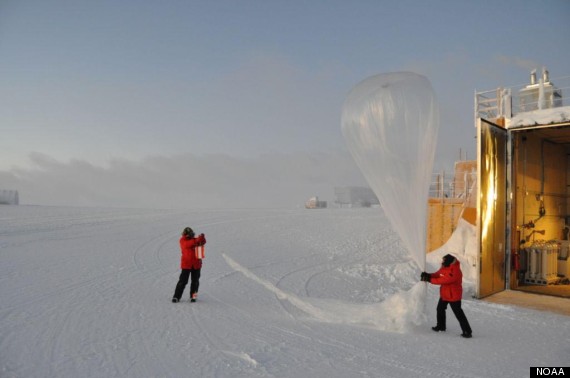High above Antarctica, the atmosphere is slowly recovering from the decades-long barrage of manmade chemicals that ate a hole in the protective ozone layer.
But the legacy of that destruction lingers. Scientists have linked the ozone hole that forms each Antarctic spring high above Earth to changes in the fierce band of westerly winds that swirls around Antarctica. Those winds, closer to the continent's surface, have grown stronger and moved poleward over the past several decades.
This NASA animation shows variations in the ozone holes that developed over the South Pole each Antarctic spring from 1979 to 2013. Purple and blue areas have the least ozone, while yellows and reds have the most. Credit: NASA.
And now a new study suggests that the ozone hole has an even broader reach. It finds evidence those shifting winds are speeding circulation patterns in polar waters. That shift is important because it may already be weakening the Southern Ocean's ability to absorb carbon dioxide from the atmosphere and slow the march of manmade climate change.
Even a small change in the Southern Ocean carbon sink could have a noticeable impact, because the region's waters takes in about 40 percent of the total carbon absorbed by the world's seas.
"The models were indicating there could be some change in ocean circulation (caused by ozone depletion), but there was a lot of debate about whether what the models were saying was actually happening," said lead author Darryn Waugh, a climate scientist at Johns Hopkins University.
His research, published Thursday in the journal Science, bears those models out. It was published alongside a separate study, from researchers at Pennsylvania State University, that affirms the ozone hole has been the main driver of the changes in Antarctica's winds, dwarfing the role played by climate change.
Waugh and colleagues in the U.S. and Australia found that in the subtropical Southern Hemisphere, water 500 to 1,000 meters deep appear to be growing "younger." That's a sign that north-south circulation in the deep ocean has been speeding up, sending surface water from the ocean surface near the pole to those intermediate depths more quickly, he said.
At the same time, the currents closer to Antarctica's shores appear to be pushing more old, deep water up to the ocean surface.
Scientists worry that the increasing upwelling of that water, hundreds of years old and naturally rich in carbon dioxide, is reducing the amount of manmade carbon absorbed by sub-polar waters.

NOAA staff at the United States' South Pole research station prepare to release a balloon that will measure the strength of the ozone layer high above Antarctica. Credit: NOAA.
"The amount of carbon that goes from the atmosphere into the ocean depends on the balance between the amount of carbon in the atmosphere and the amount of carbon in surface water," Waugh said.
If surface waters are already rich in carbon, "that would mean more of the carbon we're producing would stay in the atmosphere, and that would contribute more to climate change," he said.
Michael Meredith, a physical oceanographer with the British Antarctic Survey who was not involved in either study, said the new research drives home the importance of the Southern Ocean carbon sink. "It's doing us a very big favor, if you like, by taking carbon from the atmosphere and slowing the rate of atmospheric climate change," he said.
Meredith, who called the new study "a strong and important paper," said the question now is what will happen as the ozone layer slowly heals and human activities pump out increasing amounts of greenhouse gases.
With the 1987 Montreal Protocol, which bans the use of ozone-destroying chemicals, now in force, researchers expect the ozone layer to recover by mid-century.
"The future of the circulation in the Southern Ocean, and the impact that it has on global climate change now seems to be very strongly tied to what happens to the westerly winds in the future," Meredith said.
The second study, by Pennsylvania State University researchers, is a small step toward answering that question, said Julie Arblaster, a climate scientist at Australia's Bureau of Meteorology, who called the analysis' use of wind speed and direction observations "sophisticated."
It's the first paper to use such observations — not model simulations — to determine what roles ozone depletion and climate change have played in shifting westerly winds poleward.
That could help researchers identify which climate models will do the best job projecting how the wind pattern will change as the ozone layer strengthens and climate change intensifies.
But first, they'll have to figure out just how both factors alter westerly winds — no small task.
"The next step is to understand the mechanism," Arblaster said. "Because if we can understand the mechanism, we can increase our confidence in projections for the future."
